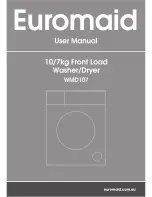
20 www.electrolux.com
Mould stains
: treat with bleach, rinse
well (whites and fast coloureds only).
Grass
: soap lightly and treat with bleach
(whites and fast coloureds only).
Ball point pen and glue
: moisten with
acetone (*), lay the garment on a soft
cloth and dab the stain.
Lipstick
: moisten with acetone (*) as
above, then treat stains with methylated
spirits. Remove any residual marks from
white fabrics with bleach.
Red wine
: soak in water and detergent,
rinse and treat with acetic or citric acid,
then rinse. Treat any residual marks with
bleach.
Ink
: depending on the type of ink,
moisten the fabric first with acetone (*),
then with acetic acid; treat any residual
marks on white fabrics with bleach and
then rinse thoroughly.
Tar stains
: first treat with stain remover,
methylated spirits or benzine, then rub
with detergent paste.
(*) do not use acetone on artificial silk.
Low sudsing detergent is required for this
washing machine to prevent oversudsing
problems, unsatisfied washing result and
harm to the machine. Low sudsing
detergents designed for front load
washing machines are labelled “Front
Loading”, “high efficiency”, “HE”, such as
Cold Power for Front Loaders or “Matic”.
6.6
Detergents Type And
Quantity Of Detergent
Do not use wrong types of detergent,
such as Top Loading, Handwash
detergent or Soap-Based products in
your frontload washing machine. This
can result in excessive suds, longer
cycle time, low spin speeds, poor
rinsing and overloading of the motor.
The choice and quantity of detergent will
depend on ;
type of fabric (delicates, woollens,
cottons, etc.) ;
degree of soil ;
size of the load ;
wash temperature ; and
hardness of the water used.
the colour of clothes ;
Information on hardness of the water in
your area can be obtained from the
relevant water supply company, or from
your local authority.
You may have to try using the detergent
quantity as per manufacturers’
instructions then compare the wash result
to the list below and adjust the amount of
detergent for your future washes
accordingly.
Water hardness is classified by so-called
“degrees” of hardness.
The choice of detergent and use of correct
quantities not only affects your wash
performance, but also helps to avoid waste
and protect the environment. Although
biodegradable, detergents contain
substances which in large quantities can
upset the delicate balance of nature.
Quantity of detergent to be used
the washload to turn grey,
greasy clothes.
sudsing,
inadequate rinsing.
reduced washing effect,
Not enough washing powder causes:
Too much washing powder causes:
you are washing a small load,
large amounts of foam during washing.
the laundry is lightly soiled,
Use less detergent if:
















































